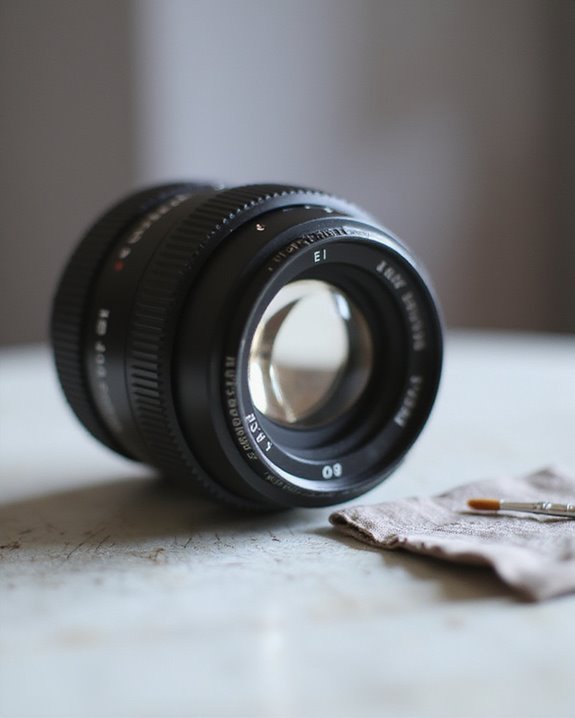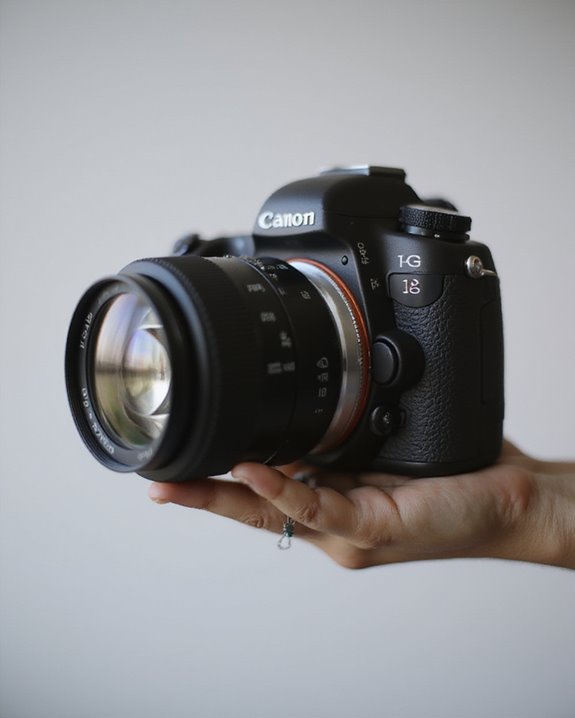While we don’t recommend attempting internal lens cleaning without expertise, you can try non-invasive methods first. Use a rocket blower while holding the lens face-down to dislodge particles, apply gentle vibration with a sonic toothbrush handle, or create static electricity with a balloon to attract dust through edges. For persistent issues affecting image quality at smaller apertures (f/8-f/22), professional cleaning services provide safer, more effective solutions. The following techniques can help you determine when DIY approaches are appropriate.
Key Takeaways
- Use blowers with the lens pointed downward to let gravity help remove internal dust particles.
- Static electricity techniques, like rubbing a balloon on fabric, can help attract dust from inside the lens.
- Gentle vibration using a sonic toothbrush handle against the lens barrel can dislodge stubborn internal particles.
- Professional cleaning is recommended for expensive equipment or when visible fungus indicates severe internal contamination.
- Maintain a low-humidity workspace (30-50% RH) to minimize static buildup when attempting internal lens cleaning.
Understanding When Your Lens Needs Internal Cleaning
When does your camera lens truly require internal cleaning, rather than a simple external wipe? Effective Symptom Recognition requires examining your images for specific quality degradations. We’ve found that visible fungus, persistent dust spots that appear in the same location across multiple images, or a noticeable haze that doesn’t improve with external cleaning typically indicate internal contamination. Additionally, a sensor swab may be necessary when dust or mold is suspected inside the lens or sensor assembly. The Contamination Effects on image quality can be substantial, with moisture potentially causing not only temporary fogging but also permanent fungal growth between elements. Internal dust accumulation progressively reduces contrast and sharpness, particularly when shooting at smaller apertures (f/8-f/22). If you’re noticing decreased optical performance despite a clean exterior, or if your images exhibit unusual artifacts, distortion, or reduced clarity, it’s time to seek professional internal lens maintenance.
Essential Tools and Safety Precautions for Lens Maintenance
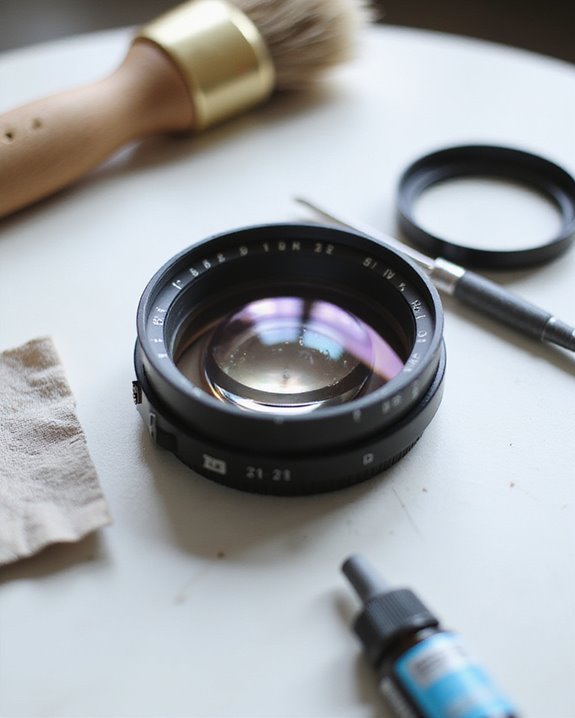
Before attempting any camera lens maintenance, we’ve found that assembling the right toolkit isn’t just helpful—it’s absolutely essential for preventing costly damage. Material Quality greatly impacts cleaning efficacy, so we recommend investing in purpose-designed tools like Giottos Rocket air blowers, microfiber cloths, lens pens, and optical-grade cleaning solutions such as Purosol. Always inspect lenses under bright light before cleaning and wash hands thoroughly to prevent oil transfer. Using professional-grade cleaning tools ensures safer and more effective results, especially when dealing with delicate optical surfaces. When cleaning, employ gentle, circular motions and never substitute household cleaners for proper solutions. Kit Customization allows photographers to address specific lens types effectively, with thorough kits including blowers, cloths, and specialized solutions. For ideal maintenance, store lenses in protective cases when not in use, avoid over-cleaning, and maintain regular inspection schedules to prevent dust accumulation.
Step-by-Step External Lens Cleaning Process
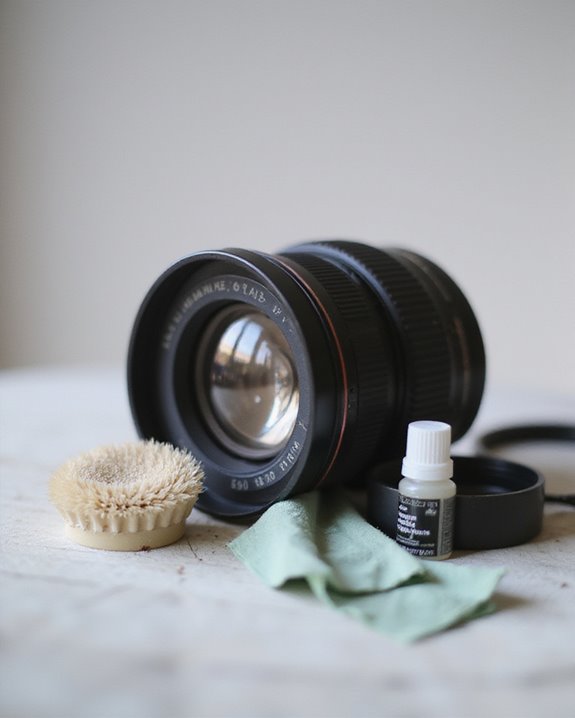
The five essential stages of external lens cleaning form a thorough process that, when followed meticulously, protects your valuable optics while ensuring ideal image quality. We begin with initial dust removal using a blower and soft-bristled brush, holding the lens inverted to leverage gravity for particulate displacement. Surface preparation follows, employing lint-free microfiber cloth for preliminary examination under angled light. Next, we apply 1-2 drops of alcohol-free solution to the cloth—never directly on the lens—and implement a center-outward spiral motion with minimal pressure. Microfiber maintenance is vital; replace cloths showing visible contamination to prevent micro-abrasions. Additionally, selecting safe lens cleaners that are ammonia-free and non-toxic can help preserve lens coatings during cleaning. Thorough inspection with a 45-degree angled flashlight reveals any remaining streaks. Our thorough storage tips include using lens caps and desiccant packs in dry environments to extend the intervals between necessary cleanings.
Techniques for Addressing Dust Inside Camera Lenses
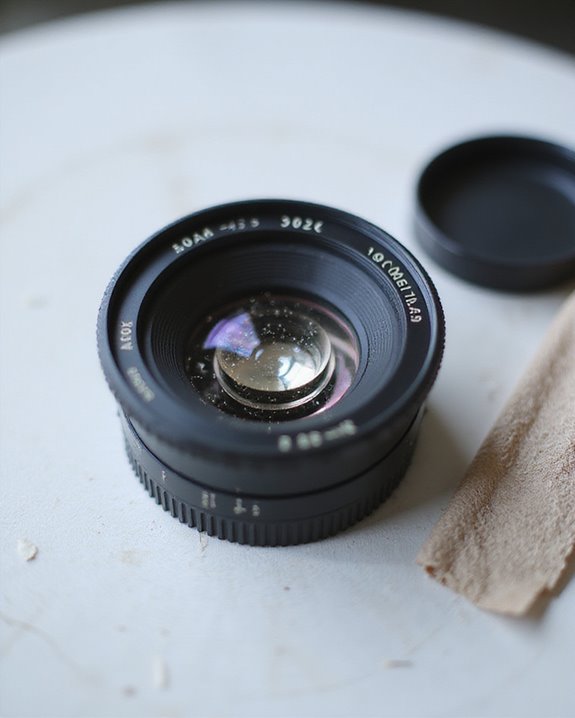
Addressing internal lens dust requires five specialized techniques that balance effectiveness with the delicate nature of optical systems. We recommend starting with air blowers, maintaining a downward lens orientation to utilize gravity assistance during cleaning. For stubborn particles, static generation methods can be employed by rubbing a balloon against fabric, then carefully positioning it near lens edges to attract dust through electrostatic principles. Vibration techniques, such as gently tapping the lens casing with a sonic toothbrush handle, can dislodge particles trapped between elements without risking internal damage. When implementing these methods, maintain a low-humidity workspace (30-50% RH) to minimize static buildup, and always perform an aperture sweep test at f/16-f/22 afterward to verify dust removal effectiveness. Remember, minimal dust rarely affects image quality.
Professional Services vs. DIY: When to Seek Expert Help
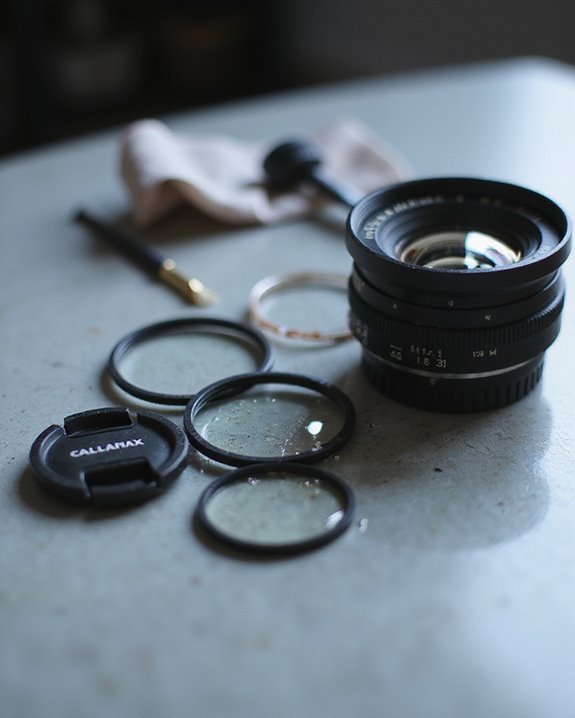
When confronting persistent dust or damage inside your camera lens, you’ll inevitably face the critical decision between professional servicing and DIY approaches. The Cost Comparison typically favors DIY methods for basic cleaning, with professional services ranging substantially higher depending on lens complexity and brand. However, the Expertise Benefits of professional technicians can’t be overstated when dealing with high-value equipment or complex internal issues.
We recommend professional cleaning when you’re facing extensive internal contamination, working with equipment valued above $500, or if the lens requires disassembly. Professionals utilize specialized tools and techniques that minimize potential damage risks. DIY approaches work well for minor dust issues when you’re comfortable with basic maintenance procedures, have appropriate cleaning supplies, and understand the inherent risks of self-servicing optical elements.
Frequently Asked Questions
Can Lens Fungus Spread to Other Camera Equipment?
We’ve seen 75% of fungus cases emerge in improperly stored lenses. Yes, lens fungus can spread to other equipment when stored together. Fungus prevention requires dry, well-ventilated storage tips: use silica gel and separate infected items.
Do UV Filters Prevent Dust From Entering Lens Internals?
No, UV filters don’t prevent dust from entering lens internals. While they provide UV protection for the front element, they aren’t an effective dust barrier for internal components. We recommend using lens caps when storing your equipment.
Is Ultrasonic Cleaning Safe for Vintage or Collectible Lenses?
We risk, we preserve, we decide carefully. Ultrasonic cleaning isn’t generally safe for vintage lenses. Historical Methods often prove gentler, and Material Compatibility is essential—many delicate coatings and adhesives in collectible optics can’t withstand the intense vibrations.
How Often Should Internal Lens Cleaning Be Performed?
We recommend internal lens cleaning every 2-3 months as a baseline maintenance schedule. However, cleaning frequency should increase if you notice visible dirt or after shooting in dusty environments. Don’t over-clean as this risks damage.
Will Warranty Coverage Be Voided by DIY Internal Lens Cleaning?
Safe externally, risky internally—we’re talking Voidance Factors here. Yes, DIY internal lens cleaning typically voids warranties. Most manufacturers’ Policy Implications are clear: only authorized technicians should perform internal work to maintain coverage protection.

